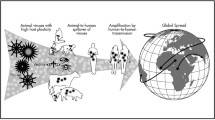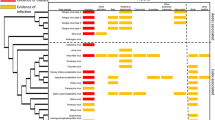Abstract
Pathogens invade new host niches all the time. The global invasion of the human niche by SARS-CoV-2 during the 2020–22 pandemic is the most recent example, but cross-species transmission is ubiquitous. In 2009 Influenza A/H1N1pdm09 emerged and spread globally most likely after a triple recombination of human, avian, and porcine viral segments (Smith et al., 2009a). The HIV-1 pandemic started in the mid-twentieth century probably from bushmeat spillover of chimpanzee simian immunodeficiency virus, which itself is thought to have originated from spillovers from other primates, to go global in the 1970s (Hemelaar, 2012). Cross-species transmission is not just an issue of zoonotic spillover or anthropogenic spillback, it is equally important as spillover among animal species.
This chapter uses the following R packages: scatterplot3d, raster, gdistance, maptools, rgdal, maps and ncf.
A five minute epidemics MOOC on spatial spread can be seen on YouTube: https://www.youtube.com/watch?v=WPjsAdyD1Gg
Access this chapter
Tax calculation will be finalised at checkout
Purchases are for personal use only
Similar content being viewed by others
Notes
- 1.
- 2.
Engen et al. (2021) discuss an alternative diffusion approximation approach to study this issue.
- 3.
Though there are Cetacean morbilliviruses documented from rare species of toothed whales which mode of persistence is not understood (Van Bressem et al., 2014).
- 4.
Manipulation of geospatial data is an enormous field and the R community has generated a lot of resources beyond the scope of this text. The code is adopted from https://stackoverflow.com/questions/69258889.
- 5.
Conventional usage is to use “eliminate” for regional control and “eradicate” for global control; smallpox and Rinderpest are the only two viruses that have been eradicated through vaccination.
- 6.
https://tinyurl.com/msszkdjw links to visualization of the invasion and elimination of fox rabies across Switzerland between 1967 and 1999.
- 7.
The code is actually vectorized so can accommodate N as a vector of varying population sizes.
- 8.
So for this code to work the previous susceptible reconstruction must be available.
- 9.
As described by watchmakers centuries ago who noted how clocks hanging on a common wall would lock-step.
References
Anderson, R. M., Jackson, H. C., May, R. M., & Smith, A. M. (1981). Population dynamics of fox rabies in Europe. Nature, 289(5800), 765–771.
Bailey, N. T. J. (1957). The mathematical theory of epidemics. London: Griffin.
Bartlett, M. S. (1960a). Stochastic population models in ecology and epidemiology. Wiley.
Bartlett, M. S. (1960b). The critical community size for measles in the U.S. Journal of Royal Statistical Society A, 123, 37–44.
Bjørnstad, O. N. (2000). Cycles and synchrony: Two historical ‘experiments’ and one experience. Journal of Animal Ecology, 869–873.
Bjørnstad, O. N., Ims, R. A., & Lambin, X. (1999b). Spatial population dynamics: Analyzing patterns and processes of population synchrony. Trends in Ecology and Evolution, 14(11), 427–432.
Bjørnstad, O. N., Shea, K., Krzywinski, M., & Altman, N. (2020a). Modeling infectious epidemics. Nature Methods, 17(5), 455–456.
Blumberg, S., & Lloyd-Smith, J. O. (2013b). Inference of R0 and transmission heterogeneity from the size distribution of stuttering chains. PLoS Computational Biology, 9(5), e1002993.
Engen, S., Tian, H., Yang, R., Bjørnstad, O. N., Whittington, J. D., & Stenseth, N. C. (2021). The ecological dynamics of the coronavirus epidemics during transmission from outside sources when R0 is successfully managed below one. Royal Society Open Science, 8(6), 202234.
Farrington, C. P., & Grant, A. D. (1999). The distribution of time to extinction in subcritical branching processes: Applications to outbreaks of infectious disease. Journal of Applied Probability, 36(3), 771–779.
Farrington, C. P., Kanaan, M. N., & Gay, N. J. (2003). Branching process models for surveillance of infectious diseases controlled by mass vaccination. Biostatistics, 4(2), 279–295.
Ferrari, M. J., Grais, R. F., Bharti, N., Conlan, A. J., Bjørnstad, O. N., Wolfson, L. J., Guerin, P. J., Djibo, A., & Grenfell, B. T. (2008). The dynamics of measles in sub-Saharan Africa. Nature, 451(7179), 679–684.
Freuling, C. M., Hampson, K., Selhorst, T., Schröder, R., Meslin, F. X., Mettenleiter, T. C., & Müller, T. (2013). The elimination of fox rabies from Europe: Determinants of success and lessons for the future. Philosophical Transactions of the Royal Society B, 368(1623), 20120142.
Goldstein, J., Park, J., Haran, M., Liebhold, A., & Bjørnstad, O. N. (2019). Quantifying spatio-temporal variation of invasion spread. Proceedings of the Royal Society B, 286(1894), 20182294.
Graham, M., Winter, A. K., Ferrari, M., Grenfell, B., Moss, W. J., Azman, A. S., Metcalf, C. J. E., & Lessler, J. (2019). Measles and the canonical path to elimination. Science, 364(6440), 584–587.
Grenfell, B., & Harwood, J. (1997). (meta)population dynamics of infectious diseases. Trends in Ecology and Evolution, 12(10), 395–399.
Grenfell, B. T., Bjørnstad, O. N., & Kappey, J. (2001). Travelling waves and spatial hierarchies in measles epidemics. Nature, 414(6865), 716–723.
Hall, A. J., Jepson, P. D., Goodman, S. J., & Härkönen, T. (2006). Phocine distemper virus in the North and European seas—Data and models, nature and nurture. Biological Conservation, 131(2), 221–229.
Hammill, M. O., Stenson, G. B., Mosnier, A., & Doniol-Valcroz, T. (2021). Trends in Abundance of Harp Seals, Pagophilus Groenlandicus , in the Northwest Atlantic, 1952–2019. Canadian Science Advisory Secretariat.
Hanski, I. (1998). Metapopulation dynamics. Nature, 396(6706), 41–49.
Hanski, I. A., & Gaggiotti, O. E. (2004). Ecology, genetics and evolution of metapopulations. Academic Press.
Harding, K. C., Härkönen, T., & Caswell, H. (2002). The 2002 European seal plague: Epidemiology and population consequences. Ecology Letters, 5(6), 727–732.
Hemelaar, J. (2012). The origin and diversity of the HIV-1 pandemic. Trends in Molecular Medicine, 18(3), 182–192.
Iacono, G. L., Cunningham, A. A., Fichet-Calvet, E., Garry, R. F., Grant, D. S., Khan, S. H., Leach, M., Moses, L. M., Schieffelin, J. S., Shaffer, J. G., et al. (2015). Using modelling to disentangle the relative contributions of zoonotic and anthroponotic transmission: The case of Lassa fever. PLoS Negl ectedTropical Diseases, 9(1), e3398.
Keeling, M. J., Bjørnstad, O. N., & Grenfell, B. T. (2004). Metapopulation dynamics of infectious diseases. In Hanski, I., & Gaggiotti, O., (Eds.), Ecology, Genetics, and Evolution of Metapopulations (pp. 415–445). Elsevier.
Keeling, M. J., & Rohani, P. (2002). Estimating spatial coupling in epidemiological systems: A mechanistic approach. Ecology Letters, 5(1), 20–29.
Kendall, B. E., Bjørnstad, O. N., Bascompte, J., Keitt, T. H., & Fagan, W. F. (2000). Dispersal, environmental correlation, and spatial synchrony in population dynamics. The American Naturalist, 155(5), 628–636.
Klepac, P., Metcalf, C. J. E., McLean, A. R., & Hampson, K. (2013). Towards the endgame and beyond: Complexities and challenges for the elimination of infectious diseases. Philosophical transactions of the Royal Society B.
Klepac, P., Pomeroy, L. W., Bjørnstad, O. N., Kuiken, T., Osterhaus, A. D., & Rijks, J. M. (2009). Stage-structured transmission of phocine distemper virus in the Dutch 2002 outbreak. Proceedings of the Royal Society B, 276(1666), 2469–2476.
Kröger, M., Turkyilmazoglu, M., & Schlickeiser, R. (2021). Explicit formulae for the peak time of an epidemic from the SIR model. Which approximant to use? Physica D, 425, 132981.
Lau, M. S. Y., Becker, A. D., Korevaar, H. M., Caudron, Q., Shaw, D. J., Metcalf, C. J. E., Bjørnstad, O. N., & Grenfell, B. T. (2020). A competing-risks model explains hierarchical spatial coupling of measles epidemics en route to national elimination. Nature Ecology and Evolution, 4, 934–939.
Lloyd-Smith, J. O., George, D., Pepin, K. M., Pitzer, V. E., Pulliam, J. R. C., Dobson, A. P., Hudson, P. J., & Grenfell, B. T. (2009). Epidemic dynamics at the human-animal interface. Science, 326(5958), 1362–1367.
Metcalf, C. J. E., Hampson, K., Tatem, A. J., Grenfell, B. T., & Bjørnstad, O. N. (2013). Persistence in epidemic metapopulations: quantifying the rescue effects for measles, mumps, rubella and whooping cough. PloS One, 8(9), e74696.
Mollison, D. (1991). Dependence of epidemic and population velocities on basic parameters. Mathematical Biosciences, 107(2), 255–287.
Murray, J. D., Stanley, E. A., & Brown, D. L. (1986). On the spatial spread of rabies among foxes. Proceedings of the Royal Society of London. Series B, 111–150.
Reluga, T. C., Medlock, J., & Galvani, A. P. (2006). A model of spatial epidemic spread when individuals move within overlapping home ranges. Bulletin of Mathematical Biology, 68(2), 401–416.
Rohani, P., Earn, D. J., & Grenfell, B. T. (1999). Opposite patterns of synchrony in sympatric disease metapopulations. Science, 286(5441), 968–971.
Rohani, P., Keeling, M. J., & Grenfell, B. T. (2002). The interplay between determinism and stochasticity in childhood diseases. The American Naturalist, 159(5), 469–481.
Ruxton, G. D. (1994). Low levels of immigration between chaotic populations can reduce system extinctions by inducing asynchronous regular cycles. Proceedings of the Royal Society of London B, 256(1346), 189–193.
Scherer, A., & McLean, A. (2002). Mathematical models of vaccination. British Medical Bulletin, 62(1), 187–199.
Smith, D. L., Lucey, B., Waller, L. A., Childs, J. E., & Real, L. A. (2002a). Predicting the spatial dynamics of rabies epidemics on heterogeneous landscapes. Proceedings of the National Academy of Sciences, 99(6), 3668–3672.
Smith, G. J., Vijaykrishna, D., Bahl, J., Lycett, S. J., Worobey, M., Pybus, O. G., Ma, S. K., Cheung, C. L., Raghwani, J., Bhatt, S., et al. (2009a). Origins and evolutionary genomics of the 2009 swine-origin H1N1 influenza A epidemic. Nature, 459(7250), 1122–1125.
Special Commitee on Seals. (2002). Scientific advice on matters related to the management of seal populations. Technical report, Sea Mammal Research Unit, St Adrews University.
Swinton, J. (1998). Extinction times and phase transitions for spatially structured closed epidemics. Bulletin of Mathematical Biology, 60(2), 215–230.
Swinton, J., Harwood, J., Grenfell, B. T., & Gilligan, C. A. (1998). Persistence thresholds for phocine distemper virus infection in harbour seal Phoca vitulina metapopulations. Journal of Animal Ecology, 67, 54–68.
Taber, S. W., & Pease, C. M. (1990). Paramyxovirus phylogeny: Tissue tropism evolves slower than host specificity. Evolution, 44(2), 435–438.
Takahashi, S., Metcalf, C. J. E., Ferrari, M. J., Moss, W. J., Truelove, S. A., Tatem, A. J., Grenfell, B. T., & Lessler, J. (2015). Reduced vaccination and the risk of measles and other childhood infections post-Ebola. Science, 347(6227), 1240–1242.
Van Bressem, M.-F., Duignan, P. J., Banyard, A., Barbieri, M., Colegrove, K. M., De Guise, S., Di Guardo, G., Dobson, A., Domingo, M., Fauquier, D., et al. (2014). Cetacean morbillivirus: Current knowledge and future directions. Viruses, 6(12), 5145–5181.
van den Bosch, F., Metz, J. A. J., & Diekmann, O. (1990). The velocity of spatial population expansion. Journal of Mathematical Biology, 28(5), 529–565.
Waller, L. A., & Gotway, C. A. (2004). Linking spatial sxposure data to health events. In Applied spatial statistics for public health data (pp. 325–443). John Wiley and Sons.
Xia, Y., Bjørnstad, O. N., & Grenfell, B. T. (2004). Measles metapopulation dynamics: A gravity model for epidemiological coupling and dynamics. The American Naturalist, 164(2), 267–281.
Author information
Authors and Affiliations
Rights and permissions
Copyright information
© 2023 The Author(s), under exclusive license to Springer Nature Switzerland AG
About this chapter
Cite this chapter
Bjørnstad, O. (2023). Invasion and Eradication. In: Epidemics. Use R!. Springer, Cham. https://doi.org/10.1007/978-3-031-12056-5_15
Download citation
DOI: https://doi.org/10.1007/978-3-031-12056-5_15
Published:
Publisher Name: Springer, Cham
Print ISBN: 978-3-031-12055-8
Online ISBN: 978-3-031-12056-5
eBook Packages: Mathematics and StatisticsMathematics and Statistics (R0)




